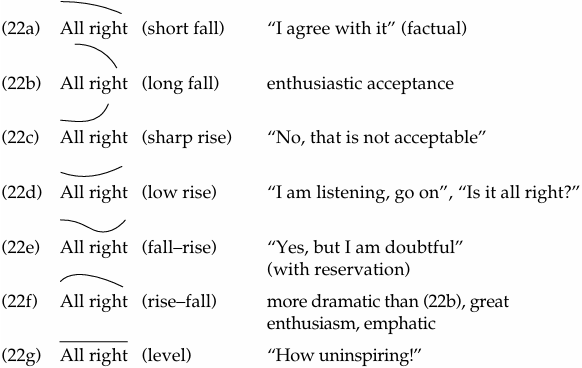Intonation
We defined intonation as pitch variations that occur over a phrase or sentence. Intonation contours can be described in terms of tone groups or intonational phrases. A tone group is the part of a sentence over which an intonation contour extends. Within a tone group, each stressed syllable has a minor pitch increase, but there is one syllable in which this pitch increase is more significant. The syllable that carries the major pitch change is called the tonic syllable. For example, in the following sentence:

the elements marked with a ´ are stressed, but the major pitch increase is on teacher, which is marked with an asterisk. Since in the usual cases in English, the utterance-initial position is reserved for shared (old) information, and the new information is placed in utterance-final position, the most common pattern is to put the tonic accent on the last stressed lexical item (noun, verb, adjective, adverb).
One should note, however, that this is merely a tendency, as we may easily f ind cases where the tonic accent is brought forward.

In (2b) the tonic accent on somewhat is a result of emphasis (contrast). Not all cases of placing the tonic accent earlier than the last stressed lexical item involve contrast/emphasis, as exemplified in (3):

It is important to note that a tone group is a unit of information rather than a syntactically definable unit. Thus, the way the speaker shapes his or her utterance(s) depends on what he or she considers to be the important point(s) in the sentence. In (3), the speaker has the lexical item party/letters that has the greater importance. Likewise, while the neutral expression of (4a) will assign the tonic accent to the last lexical word vegetable (talking about the category/characterization of spinach),

we would be likely to bring the tonic accent on to spinach in a discussion of vegetables and considering what would fit into that group:

Before we leave this issue, it will be useful to mention some other cases that are also exceptions to the tonic accent falling on the last lexical item. The first one of these relates to the tone group that has an intransitive verb or verb phrase whose subject is non-human:

The second involves certain types of adverbials in final position. Sentential adverbials (i.e. those that modify the whole sentence) and adverbials of time usually do not take the tonic accent:

The sentences we have considered so far in (1)–(6) all are examples of ‘falling intonation contour’, which is quite typical of utterances that express finality. It may be useful, however, to make a distinction between ‘full’ (or ‘long’) fall versus ‘low’ (or ‘short’) fall. A full fall is unmarked for declaratives where there is clear finality in the statement (i.e. there is nothing more to be said).

This pattern is common in expressing emotional involvement:

A falling contour is also typical of wh-questions (questions that start with a wh- word such as what, which, where):

While a full (or ‘long’) fall shows a definitive, involved mood, a short (or ‘low’) fall is, generally, an indication of a detached mood in the speaker. It displays a rather neutral, perfunctory attitude:

If falling contour is indicative of ‘finality’ or ‘completion’, rising intonation represents ‘non-definiteness’, ‘lack of assurance’, or ‘incompletion’. This pitch pattern is addressee-oriented, and the degree of ‘rise’ is matched to the degree of uncertainty or incompleteness. Accordingly, we can describe this pattern as:

High (or ‘long’) rise is a more marked pattern, which is indicative of an attitude of puzzlement or unbelieving:
• In yes–no questions (typical order, or with statement order), such as:

the speaker has the attitude of asking “are you sure you know what you are saying?” or “this is hard to believe”.
A low rise, on the other hand, is more common and is used in a variety of situations:
• In yes–no questions (typical order or with statement order), such as:

• Echo questions, such as:

• Repetition questions, such as:

Note that this is different from (9), where the question is information seeking.
• Open-choice alternative questions, such as:

Note the falling contour for the ‘closed choice’ alternative:

• Certain tag questions that signal uncertainty, such as:

display rising intonation. However, if the sentence is uttered when eliciting agreement or confirmation, then it will end in a falling contour. In this case it is indeed a rhetorical question, as no answer is sought.
• Items in a list prior to the last item, such as:

• Questions that display readiness to present some new information, such as:

If this is uttered as a neutral ‘information-seeking’ question, it will end in a falling pitch.
Other than the falling and rising intonation discussed thus far, there are two other patterns that are combinatory. A falling–rising intonation is indicative of an agreement with reservation:

The speaker accepts that it can be done the way the hearer suggested and at the same time expresses some reservation or hesitation (i.e. “I don’t think you should”).
The opposite, a rising–falling intonation, which is the dramatic equivalent of a simple ‘fall’, reveals strong feelings of approval or disapproval:

Finally, mention should be made of a level intonation, which marks a bored or sarcastic attitude:

Putting all these together, we can clearly interpret the messages intended by the speaker:

 الاكثر قراءة في Phonology
الاكثر قراءة في Phonology
 اخر الاخبار
اخر الاخبار
اخبار العتبة العباسية المقدسة


